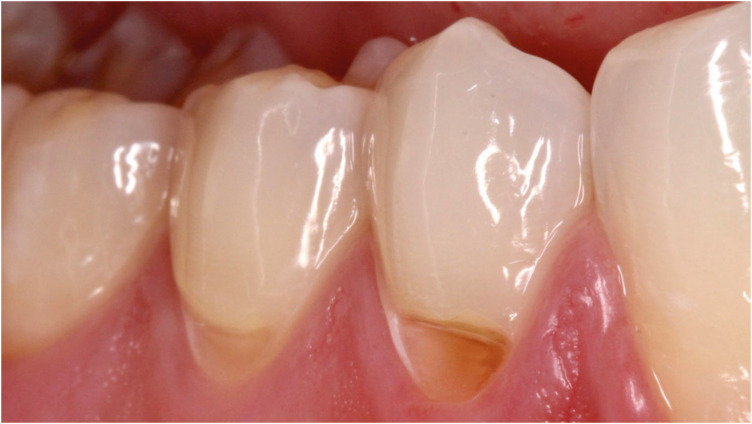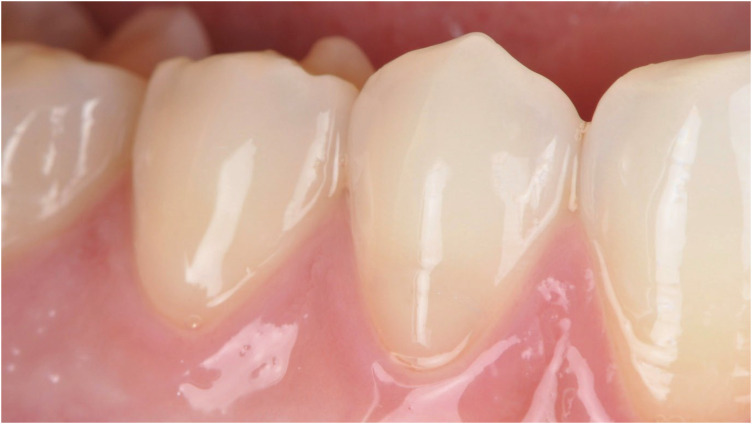1. Teixeira DNR, Thomas RZ, Soares PV, Cune MS, Gresnigt MMM, Slot DE. Prevalence of noncarious cervical lesions among adults: a systematic review. J Dent. 2020; 95:103285. PMID:
32006668.
2. Warreth A, Abuhijleh E, Almaghribi MA, Mahwal G, Ashawish A. Tooth surface loss: a review of literature. Saudi Dent J. 2020; 32:53–60. PMID:
32071532.
3. Duangthip D, Man A, Poon PH, Lo ECM, Chu CH. Occlusal stress is involved in the formation of non-carious cervical lesions. A systematic review of abfraction. Am J Dent. 2017; 30:212–220. PMID:
29178704.
4. Yan J, Xie W, Zhang L, Wang J, Wang J, Liu K, et al. Low torque is a risk factor for non-carious cervical lesions (NCCLs) in maxillary premolars. Am J Dent. 2021; 34:245–249. PMID:
34689446.
5. Fahl N Jr. Direct-indirect class v restorations: a novel approach for treating noncarious cervical lesions. J Esthet Restor Dent. 2015; 27:267–284. PMID:
26031691.
6. Durán JC, Alarcón C, De la Jara D, Pino R, Lanis A. Multidisciplinary treatment of deep non-carious cervical lesion with a CAD/CAM chairside restoration in combination with periodontal surgery: a 60-month follow-up technique report. Clin Adv Periodontics. 2021; 11:87–92. PMID:
33569921.
7. Staninec M, Tsuji G. Restoration of non-carious cervical lesions with ceramic inlays: a possible model for clinical testing of adhesive cements. Dent Hypotheses. 2012; 3:155–158.
8. Fathy H, Hamama HH, El-Wassefy N, Mahmoud SH. Clinical performance of resin-matrix ceramic partial coverage restorations: a systematic review. Clin Oral Investig. 2022; 26:3807–3822.
9. Alharbi A, Rocca GT, Dietschi D, Krejci I. Semidirect composite onlay with cavity sealing: a review of clinical procedures. J Esthet Restor Dent. 2014; 26:97–106. PMID:
24341472.
10. Azarbal A, Azarbal M, Engelmeier RL, Kunkel TC. Marginal fit comparison of CAD/CAM crowns milled from two different materials. J Prosthodont. 2018; 27:421–428. PMID:
29143397.
11. de Paris Matos T, Wambier LM, Favoreto MW, Rezende CEE, Reis A, Loguercio AD, et al. Patient-related outcomes of conventional impression making versus intraoral scanning for prosthetic rehabilitation: a systematic review and meta-analysis. J Prosthet Dent. 2023; 130:19–27. PMID:
34756424.
12. Joda T, Zarone F, Ferrari M. The complete digital workflow in fixed prosthodontics: a systematic review. BMC Oral Health. 2017; 17:124. PMID:
28927393.
13. Brignardello-Petersen R. There seem to be similar outcomes when restoring noncarious cervical lesions with direct or semidirect techniques after 2 years. J Am Dent Assoc. 2020; 151:e4. PMID:
31703804.
14. Caneppele TMF, Meirelles LCF, Rocha RS, Gonçalves LL, Ávila DMS, Gonçalves SEP, et al. A 2-year clinical evaluation of direct and semi-direct resin composite restorations in non-carious cervical lesions: a randomized clinical study. Clin Oral Investig. 2020; 24:1321–1331.
15. Ekici MA, Egilmez F, Cekic-Nagas I, Ergun G. Physical characteristics of ceramic/glass-polymer based CAD/CAM materials: effect of finishing and polishing techniques. J Adv Prosthodont. 2019; 11:128–137. PMID:
31080574.
16. Boing TF, de Geus JL, Wambier LM, Loguercio AD, Reis A, Gomes OMM. Are glass-ionomer cement restorations in cervical lesions more long-lasting than resin-based composite resins? A systematic review and meta-analysis. J Adhes Dent. 2018; 20:435–452. PMID:
30349908.
17. Mahn E, Rousson V, Heintze S. Meta-analysis of the influence of bonding parameters on the clinical outcome of tooth-colored cervical restorations. J Adhes Dent. 2015; 17:391–403. PMID:
26525003.
18. Paula AM, Boing TF, Wambier LM, Hanzen TA, Loguercio AD, Armas-Vega A, et al. Clinical performance of non-carious cervical restorations restored with the “sandwich technique” and composite resin: a systematic review and meta-analysis. J Adhes Dent. 2019; 21:497–508. PMID:
31802065.
19. Bustamante-Hernández N, Montiel-Company JM, Bellot-Arcís C, Mañes-Ferrer JF, Solá-Ruíz MF, Agustín-Panadero R, et al. Clinical behavior of ceramic, hybrid and composite onlays. A systematic review and meta-analysis. Int J Environ Res Public Health. 2020; 17:17.
20. Riley DS, Barber MS, Kienle GS, Aronson JK, von Schoen-Angerer T, Tugwell P, et al. CARE guidelines for case reports: explanation and elaboration document. J Clin Epidemiol. 2017; 89:218–235. PMID:
28529185.
21. Hickel R, Mesinger S, Opdam N, Loomans B, Frankenberger R, Cadenaro M, et al. Revised FDI criteria for evaluating direct and indirect dental restorations-recommendations for its clinical use, interpretation, and reporting. Clin Oral Investig. 2023; 27:2573–2592.
22. Alvarez-Arenal A, Alvarez-Menendez L, Gonzalez-Gonzalez I, Alvarez-Riesgo JA, Brizuela-Velasco A, deLlanos-Lanchares H. Non-carious cervical lesions and risk factors: a case-control study. J Oral Rehabil. 2019; 46:65–75. PMID:
30252966.
23. Coldea A, Swain MV, Thiel N. Mechanical properties of polymer-infiltrated-ceramic-network materials. Dent Mater. 2013; 29:419–426. PMID:
23410552.
24. Peumans M, De Munck J, Mine A, Van Meerbeek B. Clinical effectiveness of contemporary adhesives for the restoration of non-carious cervical lesions. A systematic review. Dent Mater. 2014; 30:1089–1103. PMID:
25091726.
25. Marchesi G, Camurri Piloni A, Nicolin V, Turco G, Di Lenarda R. Chairside CAD/CAM materials: current trends of clinical uses. Biology (Basel). 2021; 10:1170. PMID:
34827163.
26. Andrade ACM, Borges AB, Kukulka EC, Moecke SE, Scotti N, Comba A, et al. Optical property stability of light-cured versus precured CAD-CAM composites. Int J Dent. 2022; 2022:2011864. PMID:
35685910.
27. Beyabanaki E, Eftekhar Ashtiani R, Feyzi M, Zandinejad A. Evaluation of microshear bond strength of four different CAD-CAM polymer-infiltrated ceramic materials after thermocycling. J Prosthodont. 2022; 31:623–628. PMID:
34890485.
28. Della Bona A, Corazza PH, Zhang Y. Characterization of a polymer-infiltrated ceramic-network material. Dent Mater. 2014; 30:564–569. PMID:
24656471.
29. Motevasselian F, Amiri Z, Chiniforush N, Mirzaei M, Thompson V.
In vitro evaluation of the effect of different surface treatments of a hybrid ceramic on the microtensile bond strength to a luting resin cement. J Lasers Med Sci. 2019; 10:297–303. PMID:
31875122.
30. Spitznagel FA, Scholz KJ, Strub JR, Vach K, Gierthmuehlen PC. Polymer-infiltrated ceramic CAD/CAM inlays and partial coverage restorations: 3-year results of a prospective clinical study over 5 years. Clin Oral Investig. 2018; 22:1973–1983.
31. Castro EF, Azevedo VLB, Nima G, Andrade OS, Dias CTDS, Giannini M. Adhesion, mechanical properties, and microstructure of resin-matrix cad-cam ceramics. J Adhes Dent. 2020; 22:421–431. PMID:
32666069.
32. Lucsanszky IJR, Ruse ND. Fracture toughness, flexural strength, and flexural modulus of new CAD/CAM resin composite blocks. J Prosthodont. 2020; 29:34–41. PMID:
31702090.








 PDF
PDF Citation
Citation Print
Print












 XML Download
XML Download